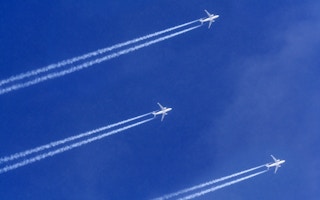Air travel is a rapidly-growing source of carbon dioxide and is helping to heat the Earth. It accounted for six per cent of the UK’s total greenhouse gas emissions in 2011.
But researchers from the University of Reading, UK, say the CO2 that aircraft emit may be less damaging to the climate than the vapour trails they often leave behind them.
Writing in the journal Environmental Research Letters, the scientists demonstrate that aircraft contribute less to global warming when they avoid the places where the thin-shaped clouds of vapour − called condensation trails, or contrails − are produced, even if that means flying further and emitting more CO2.
Wispy clouds
Contrails form only in parts of the sky with very cold and moist air, often in the ascending air around high pressure weather systems. They sometimes stay in the air for many hours, eventually spreading out to resemble natural, wispy clouds.
Previous research by scientists at Reading has shown that, on average, seven per cent of the total distance flown by aircraft is in cold, moist air where long-lasting contrails can form − 2.4 billion km out of a global total of 33 billion km flown in 2005.
“
If we can predict the regions where contrails will form, it may be possible to mitigate their effect by routing aircraft to avoid them. Our work shows that, for a rounded assessment of the environmental impact of aviation, more needs to be considered than just the carbon emissions of aircraft
Dr Emma Irvine, scientist, University of Reading’s Department of Meteorology
The new findings from Reading follow research published recently in the journal Nature Climate Change showing that the amount of global warming caused by contrails could be as large as, or even larger than, the contribution from aviation’s CO2 emissions.
The work was carried out by three scientists in Reading’s Department of Meteorology − Dr Emma Irvine, Professor Keith Shine, and Professor Sir Brian Hoskins, who is also chair of the Grantham Institute at Imperial College London.
Dr Irvine said: “If we can predict the regions where contrails will form, it may be possible to mitigate their effect by routing aircraft to avoid them. Our work shows that, for a rounded assessment of the environmental impact of aviation, more needs to be considered than just the carbon emissions of aircraft.”
Just like natural clouds, contrails reflect some of the sun’s incoming energy, and so produce a cooling effect. But they also trap some of the infra-red energy that radiates from the Earth into space, and so have a warming effect − again, like other clouds. The researchers say detailed calculations show that, generally, the warming influence is greater than the cooling.
But the picture is more complex than that. For a start, the team estimates that smaller aircraft can fly much further to avoid forming contrails than larger ones.
With a small aircraft that is predicted to form a contrail 20 miles long, an alternative route would have a smaller climate impact if it adds less than 200 miles to its journey . For larger aircraft, the alternative route could still be preferable, but only if it added less than 60 miles to the journey.
But there is a further twist. The team had to allow for the varying length of time the different impacts would persist. As Dr Irvine explained: “Comparing the relative climate impacts of CO2 and contrails is not trivial. One complicating factor is their vastly differing lifetimes. Contrails may last for several hours, while CO2 can last for decades.”
Feasible and safe
Nor are the relative climate impacts the only factors for aviators to think about. Air traffic controllers would need to be sure re-routing aircraft flight by flight is both feasible and safe, and weather forecasters would want to know whether they can reliably predict when and where contrails are likely to form.
As well as CO2, aircraft engines emit a number of other gases and particles that can also alter climate – such as oxides of nitrogen and sulphur gases − and their effects might also depend on the route taken.
The researchers have devised a framework to calculate how much further an aircraft could travel in a single flight before the extra CO2 that is emitted causes more warming than the contrail would have caused. It takes into account the characteristics of the aircraft and the prevailing weather conditions, since the altitude at which contrails are formed depends greatly on weather patterns.
They are confident their work has practical implications. “The mitigation targets currently adopted by governments all around the world do not yet address the important non-CO2 climate impacts of aviation, such as contrails,” Dr Irvine said.
“We believe it is important for scientists to assess the overall impact of aviation and the robustness of any proposed mitigation measures in order to inform policy decisions.”










